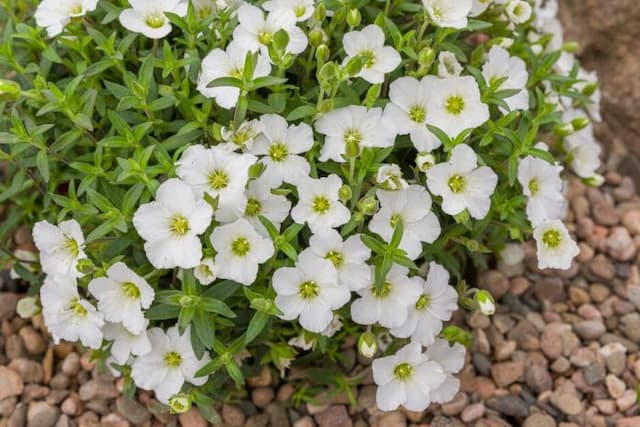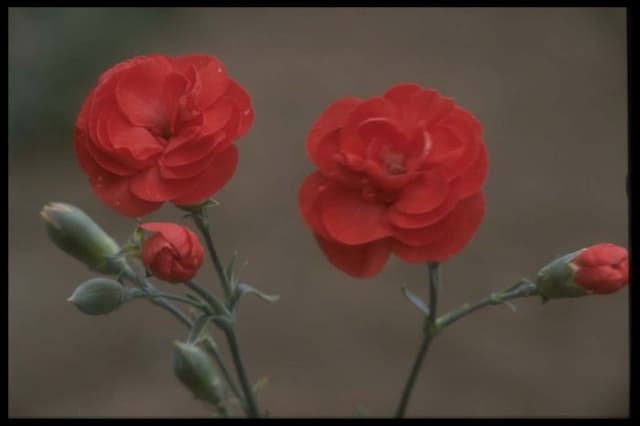Sweet William Dianthus 'Little Jock' (p)

ABOUT
The Dianthus 'Little Jock' is a charming plant that boasts a profusion of striking flowers. These blooms are typically noted for their vivid color, often presenting hues of pink, red, or purple, which may vary in intensty across the petals, sometimes exhibiting a gradient or having a delicate edge of a contrasting color, creating a subtle yet distinctive look. The flora of 'Little Jock' usually have a frilled or serrated edge, contributing to their overall ornamental quality. The foliage of the 'Little Jock' is slender and blue-green, providing a pleasantly contrasting backdrop to the brightness of the flowers. The leaves are typically narrow and have a grass-like appearance that forms a neat, compact mound or tuft from which the flower stems arise. The blooms themselves are known to possess a rich and spicy fragrance, which adds another layer of sensory appeal to the plant. This scent can be particularly strong during the morning and evening hours. Dianthus 'Little Jock', like other members of its family, is often favored by gardeners not only for its visual appeal but also for its agreeable aroma. Collectively, the attractive flowers and the complementary foliage come together to create a delightful and aesthetically pleasing plant, popular in ornamental gardens for its showy character and delightful scent. The 'Little Jock' makes an excellent choice for borders, rockeries, and containers, where its colorful display can be admired up close.
About this plant
 Names
NamesSynonyms
Sweet William, Pinks
Common names
Dianthus 'Little Jock'
 Toxicity
ToxicityTo humans
The plant in question, commonly known as Sweet William, is generally considered non-toxic to humans. Therefore, accidental ingestion is unlikely to cause any significant symptoms of poisoning. However, as with any plant, individual allergies or sensitivities could occur, and ingestion should still be avoided.
To pets
For pets, Sweet William is also generally recognized as non-toxic. This means that ingestion of this plant by dogs, cats, or other household pets is not expected to cause serious symptoms of poisoning. Nevertheless, ingestion of non-food items can sometimes lead to gastrointestinal upset in pets, such as vomiting or diarrhea, due to individual sensitivities. It's always best to prevent pets from consuming any plants not specifically intended for them.
 Characteristics
CharacteristicsLife cycle
Perennials
Foliage type
Evergreen
Color of leaves
Blue-green
Flower color
Pink
Height
6-10 inches (15-25 cm)
Spread
6-12 inches (15-30 cm)
Plant type
Herb
Hardiness zones
5-9
Native area
Europe
Benefits
 General Benefits
General Benefits- Attractive Blooms: Dianthus 'Little Jock' produces vibrant, colorful flowers that enhance the visual appeal of gardens and landscapes.
- Compact Size: Its small stature makes it suitable for borders, rock gardens, and containers where space is limited.
- Long Flowering Season: This variety tends to bloom over a long period, often from late spring to early fall, offering extended interest.
- Low Maintenance: It requires minimal care once established, making it a convenient choice for gardeners of all levels.
- Drought Tolerance: Once established, Dianthus 'Little Jock' can withstand periods of dry weather, reducing the need for frequent watering.
- Cold Hardy: It can survive in cooler climates and is capable of withstanding frost, making it a resilient choice for many regions.
- Attracts Pollinators: The flowers can attract bees and butterflies, contributing to the health of the local ecosystem by supporting pollinators.
- Deer Resistance: This plant is often resistant to deer, which can be beneficial in areas where deer browsing is a problem for gardens.
- Fragrant Flowers: The blooms of Dianthus 'Little Jock' are known for their delightful fragrance, adding another sensory dimension to the garden.
 Medical Properties
Medical PropertiesThis plant is not used for medical purposes.
 Air-purifying Qualities
Air-purifying QualitiesThis plant is not specifically known for air purifying qualities.
 Other Uses
Other Uses- Culinary Garnish: The petals of Dianthus, commonly known as Pinks, can be used to add color and a mild spicy flavor to salads or desserts.
- Botanical Dye: Pinks petals can be used to create a natural dye for coloring fabrics or paper, yielding hues ranging from pink to light purple.
- Plant Markers: The sturdy stems of Pinks can be trimmed and repurposed as natural plant markers in a garden.
- Art Supplies: Pressed Pinks flowers can be used in crafting, such as in making homemade paper or in botanical scrapbooking.
- Creative Decor: The bright flowers of Pinks can be used to decorate cakes or ice cubes, adding an edible floral touch to beverages and desserts.
- Candle Embeds: Dried Pinks petals can be embedded into candles to create a decorative and potentially fragrant element.
- Herbarium Specimens: Pinks can be pressed and preserved as herbarium specimens for educational purposes or botanical art.
- Sachets and Potpourri: Pinks flowers, when dried, can be used in sachets or potpourri mixes to impart a pleasant fragrance to linens or rooms.
- Homemade Soaps: The petals can be added to homemade soaps for exfoliating properties and visual appeal.
- Photography: Pinks, with their lively colors and interesting pattern, are excellent subjects for macro photography, contributing to artistic compositions.
Interesting Facts
 Feng Shui
Feng ShuiThe plant Dianthus is not used in Feng Shui practice.
 Zodiac Sign Compitability
Zodiac Sign CompitabilityThe plant Dianthus is not used in astrology practice.
 Plant Symbolism
Plant Symbolism- Love: The genus Dianthus, which includes the 'Little Jock', is often associated with love and affection, stemming from its attractive flowers and long history of cultivation.
- Boldness: The bright colors and striking appearance of the Dianthus 'Little Jock' can symbolize boldness or a daring spirit.
- Pure Affection: With its sweet fragrance, the Dianthus is sometimes connected to pure and deep emotions, representing genuine, heartfelt affection.
- Devotion: The hardiness and longevity of these plants, which can continue to blossom for a long period if cared for properly, symbolize steadfastness and commitment.
 Water
WaterSweet William 'Little Jock' should be watered deeply enough so that the water reaches the roots, avoiding shallow sprinklings that don't adequately hydrate the plant. Aim to water the plant when the top inch of soil feels dry to the touch, typically about once a week, depending on weather conditions. During hot, dry periods, you may need to water twice a week. Provide roughly one gallon of water per square foot every week, ensuring even distribution around the plant. Avoid overhead watering to reduce the risk of leaf diseases, and water early in the day to allow foliage to dry before evening.
 Light
LightSweet William 'Little Jock' thrives in full sun conditions, where it can receive at least six to eight hours of direct sunlight daily. A location that gets morning sun and is shielded from the intense afternoon sun can also be suitable, ensuring the plant still gets the required amount of light without being exposed to potential heat stress.
 Temperature
TemperatureSweet William 'Little Jock' prefers moderate temperatures and can generally withstand short periods of cold once established, with tolerances as low as 20°F. The ideal temperature range for optimal growth is between 60°F and 70°F. This plant may struggle with high heat, especially when temperatures exceed 85°F, so providing some afternoon shade in extremely hot climates can be beneficial.
 Pruning
PruningSweet William 'Little Jock' benefits from pruning to remove spent flowers, which encourages continued blooming and prevents the plant from putting energy into seed production. Pruning should be done throughout the blooming season as flowers fade. Additionally, cutting back the foliage after the first killing frost in autumn helps to maintain the plant's shape and health. The best time for major pruning is in early spring, as new growth begins to emerge.
 Cleaning
CleaningAs needed
 Soil
SoilThe Carnation 'Little Jock' thrives best in a well-draining, loamy soil mix with a pH between 6.0 and 7.5. A mix of two parts garden soil, one part sand or perlite, and one part compost or peat is ideal.
 Repotting
RepottingCarnations like 'Little Jock' typically need to be repotted every 1-2 years. Ensure the new pot is only slightly larger than the current one.
 Humidity & Misting
Humidity & MistingCarnations, including 'Little Jock', prefer moderate humidity levels around 40-50%, avoiding overly moist environments which can cause issues like fungal diseases.
 Suitable locations
Suitable locationsIndoor
Place Carnation 'Little Jock' in a sunny window and keep the soil moist.
Outdoor
Plant Carnation 'Little Jock' in full sun and well-draining soil.
Hardiness zone
3-9 USDA
 Life cycle
Life cycleDianthus 'Little Jock', commonly known as Pinks, begins its life cycle as a seed that germinates in moist, well-drained soil, typically in spring or early summer. Upon sprouting, the seedling grows into a rosette of blue-green leaves and gradually develops a sturdy stem. As the plant matures, flower buds form at the tips of the stems and bloom into fragrant, brightly colored flowers, most commonly in shades of pink, red, or white. After pollination, often by bees or butterflies, the flowers produce seed capsules containing numerous tiny seeds. The plant goes through a period of dormancy in late fall and winter, where above-ground growth dies back, and it survives on stored energy in its root system. The following season, Dianthus 'Little Jock' reemerges from its rootstock to continue its perennial cycle, producing new foliage and flowers.
 Propogation
PropogationPropogation time
Spring to Summer
Propogation: Dianthus 'Little Jock', commonly known as the Pink, can be propagated effectively through the method of cuttings. The best time to take cuttings for Pinks is during late spring to early summer, when the plant is actively growing. To propagate, select healthy, non-flowering shoots of about 3 to 5 inches (7.6 to 12.7 centimeters) and cut them just below a node. Remove the lower leaves and dip the cut end into a rooting hormone to encourage root growth. Then, insert the cutting into a well-draining soil mix, ensuring that at least one node is below the surface. The cuttings should be kept in a warm, bright location but out of direct sunlight to avoid scorching. Roots typically develop within a few weeks, after which the new Pink plants can be gradually acclimatized to outdoor conditions and then transplanted into their final growing positions.


![Pink [Tequila Sunrise]](/_next/image?url=https%3A%2F%2Fplants-admin.emdemapps.com%2Fimages%2Fplants%2F%2Fimages%2F604b5d995d06e.png&w=640&q=75)






